
Aristaloe is a genus of evergreen flowering perennial plants in the family Asphodelaceae from Southern Africa. Its sole species is Aristaloe aristata, known as guinea-fowl aloe or lace aloe.

The riverine rabbit, also known as the bushman rabbit or bushman hare, is a rabbit with an extremely limited distribution area, found only in the central and southern regions of the Karoo Desert of South Africa's Northern Cape Province. It is the only member of the genus Bunolagus because of unique traits that separate it from the other leporids. It is one of the most endangered mammals in the world, with only around 500 living adults, and 1500 overall.
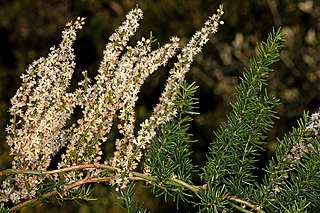
Asparagus aethiopicus, Sprenger's asparagus, is a plant native to the Cape Provinces and the Northern Provinces of South Africa. Often used as an ornamental plant, it is considered an invasive weed in many locations. Asparagus fern, asparagus grass and foxtail fern are common names; however, it is unrelated to true ferns. A. aethiopicus has been confused with A. densiflorus, now regarded as a separate species, so that information about A. aethiopicus will often be found under the name A. densiflorus.

Felicia filifolia is a Southern African member of the family Asteraceae. It is a hardy, sprawling shrub growing to about 1 metre tall. Leaves are narrow and clustered along the twigs. When blooming it is densely covered in flowerheads with ray florets that are pink-mauve to white and disc florets that are yellow. In the wild, flowers can be found August to December.
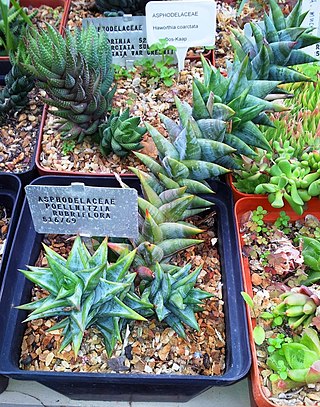
Astroloba rubriflora is a succulent plant found in the mountainous Karoo area around Robertson, South Africa. It is listed as a Vulnerable species on the IUCN global Red List.

Disa bracteata, also known as the bract disa, leek orchid or the South African weed orchid is a species of orchid native to South Africa.

Astroloba spiralis is a small succulent plant of the Astroloba genus, endemic to the southern Karoo regions of the Western and Eastern Cape Provinces, South Africa.

Daubenya zeyheri (Kunth) J.C.Manning & A.M.van der Merwe is one of 8 bulbous species in the genus, all endemic to the winter rainfall Strandveld of South Africa, and mostly growing on doleritic clays along the West Coast, Western Cape. It is closely related to Daubenya marginata J.C.Manning & A.M.van der Merwe. At first believed to consist of a single species, Daubenya aurea, the genus was expanded in 2000 to include the genera Androsiphon and Amphisiphon and various species that had previously been classified as Polyxena, Massonia, or Neobakeria. "The poor congruence between morphological and other characters within Hyacinthaceae has also made generic circumscriptions very difficult. One of the consequences of this has been the recognition of a large number of genera that are poorly defined morphologically." - All 8 species have two spreading, prostrate leaves and tubular flowers that range from white to yellow or red, and in 6 of the species are followed by smooth glossy seeds within papery capsules that lend themselves to anemochory or wind dispersal. The inflorescence is produced at ground level on a sub-surface peduncle between the two leaves. Species are variously pollinated by bees, butterflies, moths, the monkey beetle Lepisia glenlyonensis and sunbirds. The water-retaining nature of doleritic clays ensures their remaining moist for longer than clays formed from shales of the Karoo series. Exceptionally D. namaquensis is found in deep red sands and D. zeyheri in calcareous coastal sands.
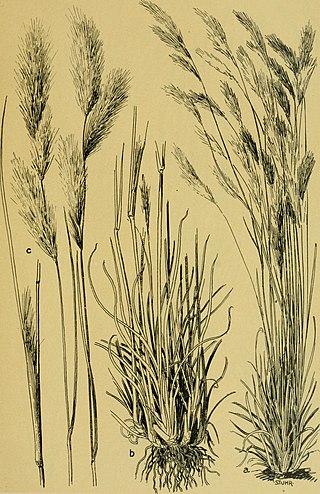
Aristida congesta is a species of grass native to all provinces of South Africa as well as Namibia, Botswana, Eswatini, Lesotho, and Mozambique. The SANBI Red List classifies it as "safe."

Eragrostis truncata is a species of grass in the family Poaceae that is native to Namibia, Botswana, and South Africa. Found most abundantly in the Nama Karoo, the plant is registered under the SANBI Red List as "safe" (LC).

Gazania lichtensteinii is a species of flowering plant in the family Asteraceae, native to South Africa and Namibia. On the SANBI Red List, it is listed as "safe".
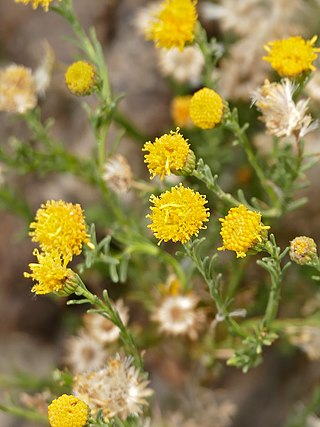
The African sheepbush is a plant native to South Africa and Namibia. It ranges throughout the Succulent Karoo, Nama Karoo, renosterveld, and fynbos, and it is listed under the SANBI Red List as "safe" (LC).
Onocosiphon suffruticosus, commonly known as the shrubby mayweed, is a flowering plant native to Namibia and the Western Cape and Northern Cape provinces of South Africa. Additionally, it can now be found in France, Australia, and the USA.

Eragrostis echinochloidea, is a species of grass native to South Africa. Listed as "safe" (LC) on the SANBI Red List, the plant can also be found in Zimbabwe, Botswana, and Namibia.

Macledium spinosum is a variable species of flowering plant in the family Asteraceae, that is endemic to the southern Cape regions of South Africa.

Dianthus basuticus, called the Drakensberg carnation, Lesotho carnation, Lesotho pink, hlokoa‑la‑tsela in the Sesotho language and Lesothose wilde angelier in Afrikaans, is a species of Dianthus native to South Africa and Lesotho.

Rhigozum trichotomum is a shrub that is native to Namibia and South Africa. It is found mainly in the Nama Karoo and is listed on the SANBI red list as 'safe' (LC). It is a woody perennial shrub that grows 1–2 m tall with thorny twigs that often branch in threes. It bears small leaves that it loses in the dry season, and produces small white flowers with yellow centers. Overgrazed areas can become covered with this plant. This indicates poor land management, and can maks the soil prone to erosion. The plant is not palatable, but acts as a nurse plant for other young plants. It occurs in areas with rainfall of 50–350 mm per year.

Roepera morgsana is a succulent plant species in the genus Roepera. It is endemic to Namibia and the Cape Provinces of South Africa.

Delosperma lehmannii is a succulent plant native to parts of the Eastern Cape Province of South Africa. Sometimes called ice plant, it is grown as a decorative houseplant for its distinctive smooth, angular leaves. The specific epithet lehmannii honors the German professor of botany in Hamburg Johann Georg Christian Lehmann.
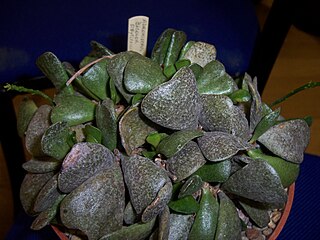
Adromischus bicolor is a perennial, succulent plant in the family Crassulaceae. The species name bicolor refers to the light, grey-green leaves spotted with purple to purple-green spots. It is endemic to the Succulent Karoo of western South Africa, as well as the Eastern Cape, South Africa.



















